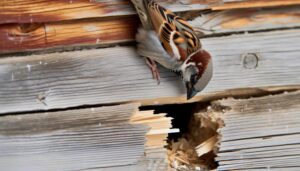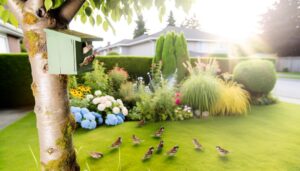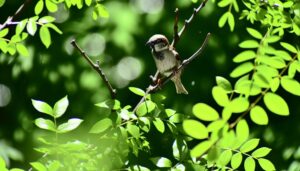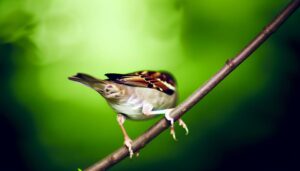How Long Do House Sparrow Eggs Take to Hatch: A Quick Incubation Guide
House sparrow eggs typically hatch within 10 to 14 days. The incubation period is influenced by environmental conditions, particularly temperature, which ideally should be maintained between 37.5°C and 38°C.
Female sparrows primarily manage incubation, with the assistance of males in foraging and nest maintenance. Precise temperature regulation is essential for embryo development and hatching success.
Deviations from best conditions can delay hatching or result in embryonic mortality. Observations indicate that factors like the nest's temperature, humidity, parental care, and protection against predators play a significant role.
For a deeper understanding of these processes, explore further.
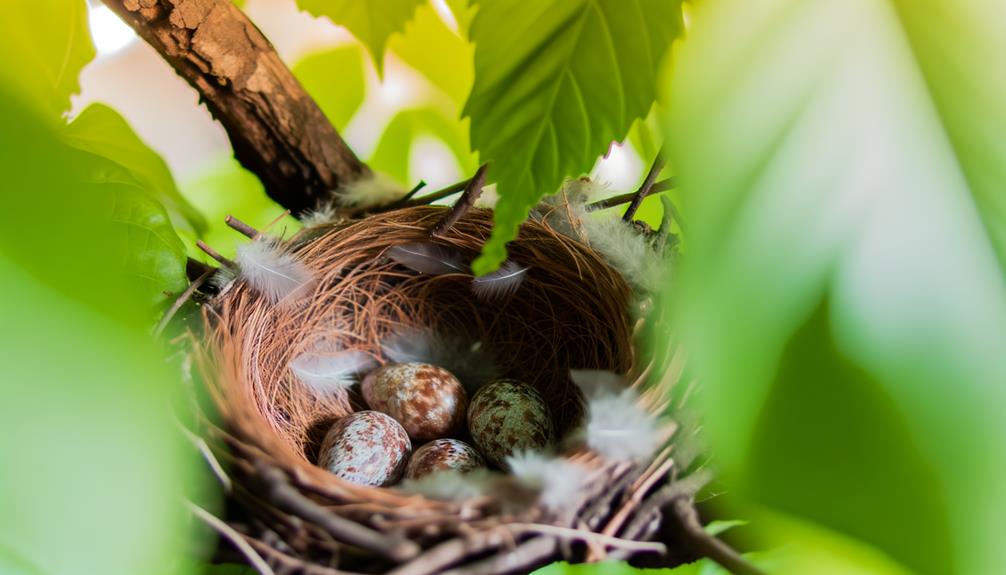
Key Takeaways
- House sparrow eggs typically hatch within 10 to 14 days.
- The average incubation period for house sparrow eggs is 11-14 days.
- Ideal incubation temperature ranges from 37°C to 38°C.
- Environmental factors influence the exact duration of egg incubation.
- Female sparrows primarily manage the incubation process.
House Sparrow Nesting Habits
House sparrows (Passer domesticus) exhibit a range of nesting habits that reflect their adaptability to diverse environments, from urban settings to rural landscapes. Their nests, typically composed of coarse grasses, feathers, and assorted debris, are often constructed in sheltered cavities. Studies have documented their proclivity for nesting in eaves, building crevices, and even traffic lights, indicative of their opportunistic nature.
Nest construction is a cooperative effort between mates, with females primarily arranging materials. Research has highlighted their preference for proximity to human activity, which affords protection from predators. Intriguingly, sparrows may also reuse and refurbish old nests, a behavior that conserves energy and resources.
These adaptive nesting behaviors underscore the species' resilience and evolutionary success in varied habitats.
Choosing a Nesting Site
House sparrows exhibit a marked preference for nesting in urban and suburban environments, often selecting sites that provide shelter and easy access to food sources. They utilize a variety of nesting materials, including twigs, grasses, and discarded human-made items, to construct their nests.
Typical nesting habits involve choosing cavities or sheltered ledges in buildings, under eaves, or within dense foliage.
Preferred Nesting Locations
Selecting a best nesting site is a critical behavior in Passer domesticus, often influenced by factors such as proximity to food sources, availability of suitable cavities, and protection from predators. Research-based observations indicate that house sparrows exhibit selective preferences:
- Urban Structures: Buildings and eaves offer ample cavities and are often close to human-provided food sources.
- Agricultural Areas: Barns and outbuildings not only provide nesting sites but also easy access to grains and insects.
- Natural Cavities: Trees with hollows or crevices provide a natural defense against predators.
These choices reflect an adaptive strategy to maximize reproductive success and offspring survival. The complexity of these decisions underscores the ecological intelligence inherent in this ubiquitous avian species.
Nesting Material Choices
In preparation for nesting, Passer domesticus exhibits a discerning selection of materials, often incorporating grasses, feathers, and twigs to construct a secure and insulated environment for their eggs. This meticulous choice aids in thermal regulation and protection from predators. Research indicates that sparrows prioritize materials based on availability and insulation properties, which greatly impact egg survival rates. Below is an observational summary of nesting materials:
| Material | Function | Availability |
|---|---|---|
| Grasses | Insulation and structure | Abundant |
| Feathers | Additional insulation | Moderate |
| Twigs | Structural support and defense | Abundant |
These selections reflect an adaptive strategy, ensuring best conditions for embryo development. Understanding these choices offers insight into avian reproductive success and environmental adaptability.
Common Nesting Habits
Building on their strategic selection of nesting materials, Passer domesticus also exhibits specific preferences for nesting sites that optimize safety and reproductive success. Field studies have identified several factors influencing site selection:
- Elevated Locations: Nests are often found in high places such as eaves, gutters, and under rooftop tiles, minimizing predation risks.
- Human Structures: They frequently utilize man-made structures like buildings, barns, and streetlights, capitalizing on their stability and protection against environmental elements.
- Cavity Sites: Natural tree cavities or crevices in walls are favored for their enclosed nature, offering additional security.
These observations align with research indicating that the availability and choice of nesting sites significantly impact the reproductive success and survival rates of house sparrows.
Egg-Laying Timeline
The egg-laying timeline of house sparrows is characterized by distinct patterns in egg-laying frequency, typically involving the deposition of one egg per day until the clutch is complete.
This is followed by an incubation period averaging 11 to 14 days, during which both male and female sparrows exhibit specific nesting behaviors to optimize embryonic development.
Research indicates that these behaviors include regular nest maintenance and temperature regulation, critical for successful hatching.
Egg-Laying Frequency
House sparrows typically exhibit a defined egg-laying frequency, often producing one egg per day during the peak of their reproductive cycle. This consistent pattern is crucial for the timely development and subsequent hatching of their offspring.
Observations indicate:
- Egg production: Typically, a female house sparrow lays between three to seven eggs in a single clutch.
- Daily laying: The laying interval is generally 24 hours, meaning one egg is laid per day.
- Clutch completion: The entire clutch is usually completed within a week, dependent on the number of eggs.
This structured timeline guarantees that all eggs are incubated simultaneously, optimizing the survival rates of the hatchlings. The regularity of egg production underscores the sparrow's reproductive efficiency and adaptability in various environments.
Incubation Period
Consistently, the incubation period for house sparrow eggs spans approximately 10 to 14 days, starting immediately after the last egg has been laid. This specific timeline is vital for synchronized hatching, maximizing the survival rate of the clutch.
Incubation is mainly the responsibility of the female, who maintains an ideal temperature range of 37.5°C to 38.5°C. Research indicates that the duration of the incubation period is influenced by ambient temperature and the nutritional status of the brooding female.
Detailed observations reveal that even minor deviations in environmental conditions can prolong or shorten the incubation period. Understanding this incubation timeline is essential for avian biologists and ornithologists focusing on the reproductive strategies and developmental stages of house sparrows.
Nesting Behavior
In house sparrows, the egg-laying timeline is carefully regulated, with the female typically laying one egg per day until the clutch is complete. This behavior promotes synchronized hatching, optimizing survival rates.
Detailed observations reveal several key stages in the nesting process:
- Nest Construction: Both sexes participate, creating a well-insulated structure using grasses and feathers.
- Egg Deposition: The female lays 3-7 eggs, each spaced by about 24 hours.
- Incubation Commencement: Incubation begins after the full clutch is laid, ensuring simultaneous development.
Research indicates that this exact timeline maximizes hatching success, as synchronized hatching allows for uniform parental care and efficient resource allocation. Understanding these behaviors provides critical insights into the reproductive strategies of house sparrows.
Clutch Size
Clutch size in house sparrows (Passer domesticus) typically ranges from three to six eggs, with variations influenced by environmental conditions and parental factors.
Research indicates that factors such as food availability, habitat quality, and climatic conditions play significant roles in determining clutch size. Higher food abundance often correlates with larger clutches, as parents are better equipped to nourish multiple offspring.
Conversely, in suboptimal conditions, smaller clutches are observed, likely an adaptive strategy to increase offspring survival rates. Parental age and experience also contribute; more experienced birds tend to produce larger clutches.
Seasonal timing impacts clutch size as well, with early-season nests generally containing more eggs compared to those laid later in the breeding season.
Incubation Period
The incubation period for house sparrow eggs typically ranges from 10 to 14 days, influenced by environmental factors.
Research indicates that best incubation temperatures, generally between 37°C to 38°C, are essential for embryonic development and hatching success.
Deviations from this temperature range can greatly impact the duration of incubation and the viability of the eggs.
Duration of Incubation
Typically, the incubation period for house sparrow eggs ranges from 10 to 14 days, depending on environmental factors and parental care. This duration is influenced by several important factors:
- Parental Behavior: Consistent incubation by both parents ensures best conditions for embryo development.
- Nest Location: Sheltered nests can provide a more stable microclimate conducive to efficient incubation.
- Egg Viability: The overall health and fertility of the eggs impact the consistency and duration of the incubation period.
Research indicates that variations in these elements can lead to slight deviations in the typical 10-14 day range. Detailed observation of these factors has shown that the synchronization of parental efforts and environmental stability are essential for the timely hatching of house sparrow eggs.
Temperature's Role
Temperature significantly influences the incubation period of house sparrow eggs, as it directly affects embryonic development rates. Research indicates that best incubation temperatures range between 37.5°C and 38°C.
Deviations from this range lead to extended or reduced hatching times, potentially affecting chick viability. Studies conducted under controlled conditions reveal that temperatures below 36°C notably slow embryogenesis, resulting in delayed hatching. Conversely, temperatures exceeding 40°C can accelerate development but increase the risk of embryonic mortality.
Field observations corroborate these findings, demonstrating that ambient temperature fluctuations impact parental incubation behavior, thereby modulating the thermal environment of the nest. Consequently, maintaining stable, best temperatures is essential for ensuring timely and successful hatching of house sparrow eggs.
Role of Parent Birds
Parental involvement in the incubation and care of house sparrow eggs is crucial for successful hatching, as both male and female sparrows exhibit distinct but complementary roles throughout the breeding period. The female primarily handles incubation, maintaining a steady temperature and ideal conditions for embryo development.
Meanwhile, the male contributes by:
- Foraging for food – Providing sustenance for the incubating female.
- Territorial defense – Protecting the nest site from predators and rival sparrows.
- Assisting in nest construction – Ensuring structural integrity and comfort.
Detailed observations indicate that such division of labor maximizes the likelihood of egg survival and successful hatching. This cooperative strategy highlights the evolutionary adaptations that house sparrows have developed to secure reproductive success.
Temperature and Hatching
Maintaining an ideal incubation temperature is a critical factor in the successful hatching of house sparrow eggs, as it directly influences embryonic development and the timing of hatching.
Research indicates that the best temperature range for house sparrow eggs lies between 37.5°C and 38°C. Deviations from this range can result in delayed hatching or embryonic mortality.
Incubation temperature affects metabolic rates, dictating the speed of developmental processes. Thermoregulation is primarily managed by the parent bird, which utilizes its brood patch to transfer heat.
Studies have shown that consistent temperature maintenance within the best range can lead to a more synchronized and successful hatching process, enhancing the survival rates of the hatchlings.
Monitoring the Nest
Effective nest monitoring is crucial for ensuring the best conditions for the incubation and hatching of house sparrow eggs. Regular observations allow for the identification of potential issues and facilitate timely interventions.
To achieve optimal results, consider the following steps:
- Frequency: Conduct daily checks to monitor temperature, humidity, and egg condition without disturbing the nest excessively.
- Documentation: Maintain detailed records of nest conditions, including dates, times, and observations, to track progress and identify patterns.
- Predator Management: Implement strategies to minimize predation risks, such as installing protective barriers or relocating nests if necessary.
Signs of Hatching
Observing the nest closely, the initial indicators of hatching can be detected through subtle changes in egg coloration and the presence of tiny cracks on the shell surface. These cracks, known as 'pipping,' result from the chick using its egg tooth to penetrate the shell. Research indicates that this process can span several hours to a full day.
Additionally, auditory cues such as faint peeping sounds can be discerned, signaling the chick's vocal activity within the egg. The eggshell may exhibit a slight wobbling motion due to the chick's movements. These signs collectively suggest imminent hatching, which typically occurs between 10 to 14 days after incubation commences, aligning with established avian developmental timelines.
First Days After Hatching
In the initial days post-hatching, nestlings exhibit rapid physiological changes. These changes include the development of thermoregulation and increased vocalization, which are critical for their survival and growth.
Observations highlight significant milestones in this period:
- Thermoregulation: Newly hatched sparrows initially rely on parental brooding to maintain body temperature. They gradually develop their own thermoregulation mechanisms.
- Feather Growth: Downy feathers begin to emerge, providing essential insulation and aiding in temperature control.
- Vocal Communication: Increased vocalizations serve as a mechanism for soliciting parental care and ensuring the chicks' nutritional needs are met.
Research underscores the importance of these early adaptations. They lay the groundwork for the house sparrows' continued development and eventual fledging from the nest.
Feeding the Chicks
As the nestlings develop thermoregulation and vocal communication skills, the parental feeding strategies become increasingly crucial in meeting the chicks' rapid growth and nutritional demands. House sparrows primarily feed their young a diet rich in insects, which provides the necessary proteins and fats essential for development. Observation has shown that feeding frequency can range from 4 to 12 times per hour, contingent upon food availability and environmental conditions.
| Feeding Frequency | Food Type | Nutritional Content |
|---|---|---|
| 4-6 times/hour | Insects (aphids) | High in proteins |
| 7-9 times/hour | Caterpillars | Rich in fats and fibers |
| 10-12 times/hour | Mixed invertebrates | Balanced nutrients |
Such parental investment is crucial for ensuring the chicks' successful progress through the critical early stages of life.
Fledging Process
The fledging process in house sparrows is a critical developmental phase characterized by the gradual shift of nestlings from complete dependence on parental care to independent foraging and flight.
During this period, several key stages can be observed:
- Wing Development: Nestlings strengthen their flight muscles and develop feather structures essential for flight.
- Parental Encouragement: Adult sparrows actively encourage fledglings to leave the nest by reducing the frequency of feeding and sometimes luring them out.
- Initial Flights: Fledglings attempt short flights, often returning to the nest for safety, gradually increasing their flight distance and maneuverability.
Research indicates that this process typically spans 14-17 days post-hatching, culminating in the fledglings' ability to sustain independent life.
Conclusion
The incubation period for house sparrow eggs typically spans 10 to 14 days, with clutch sizes ranging from 3 to 7 eggs.
Upon hatching, the altricial chicks require intensive care from both parents.
For instance, a study observed a clutch of five eggs in an urban environment, which hatched after 12 days of incubation.
The parents fed the chicks continuously, ensuring their rapid development.
This case underscores the critical role of parental involvement in the successful fledging of house sparrow chicks.

